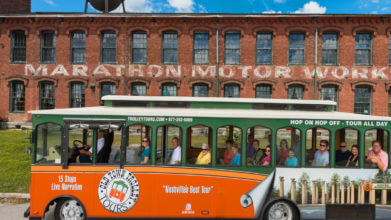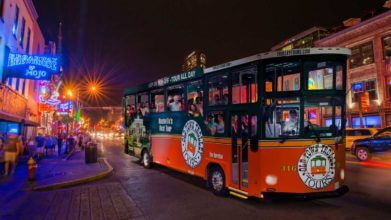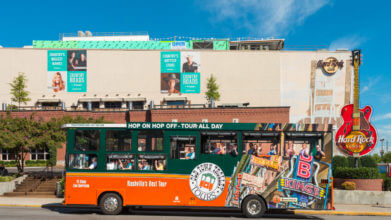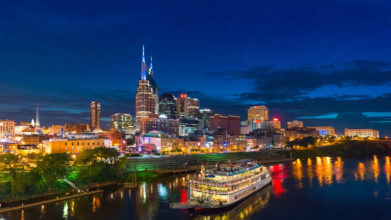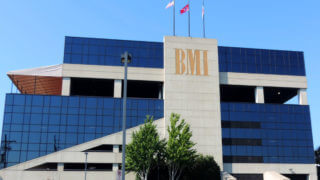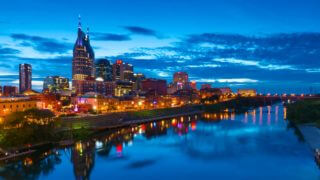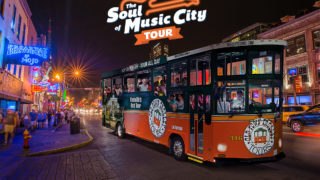Music Row
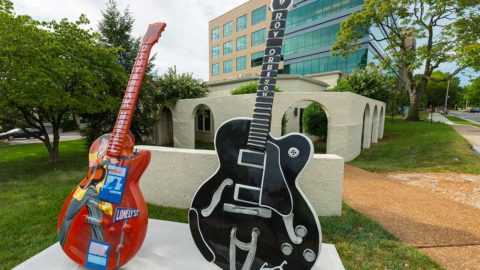
Situated southwest of downtown, Music Row is home to several businesses and attractions related to the city’s musical heritage. Considered the heart of Nashville’s entertainment industry, the Music Row area is centered on 16th and 17th Avenues South, which are known as Music Square East and West respectively. Points of interest in the district include the historic RCA Studio B, Columbia’s Historic Quonset Hut, the first recording studio on Music Row, and Owen Bradley Park as well as numerous shops and upscale eateries. “Musica,” a large bronze statue designed by Alan LeQuire, is the centerpiece of the Music Row Roundabout.
Discover Nashville’s Legendary Music Row
The best way to experience the heart of Nashville’s music scene is with Old Town Trolley Tours. Our tour provides an expertly guided journey through Music Row, the home of countless country music legends and iconic recording studios. Old Town Trolley Tours offers the most comprehensive and convenient way to see the sights that shaped American music.
Tour Music Row with Old Town Trolley
- Unmatched Access: Get a front-row seat to the historic studios, publishing houses, and record labels where country music history was made.
- Expert Narration: Our talented guides provide an entertaining and informative look into the stories and stars behind the classic hits.
- Hop-On, Hop-Off Freedom: Explore Nashville’s most famous landmarks at your own pace. Hop off to see what interests you, then hop back on the next trolley.
- Convenient Sightseeing: Avoid the hassles of parking and navigating. Old Town Trolley Tours makes seeing Music Row and other Nashville highlights effortless.
Key Features of Your Nashville Tour
- See Music Row’s Icons: Our tour takes you past the legendary recording studios on Music Row that have produced some of the greatest hits in music history.
- Explore Nashville’s Best Attractions: The tour provides the flexibility to explore popular attractions near our stops, including Belmont Mansion and the Gallery of Iconic Guitars.
- A Comprehensive City Tour: Your ticket with Old Town Trolley Tours includes access to Nashville’s most important sights beyond Music Row, giving you a complete city experience.
Always The Best Seats in Nashville!
In a city built on sound, few neighborhoods are as iconic as Music Row Nashville. This historic area is the heartbeat of Nashville’s music industry, where generations of artists, producers and songwriters have helped shape the sounds of country, pop, rock and beyond. It’s a place where music history is remembered and continues to be made every day.
From world-famous recording studios to legendary publishing houses, Music Row Nashville has been at the center of the city’s creative energy since the mid-20th century. The buildings may look quiet from the outside, but behind those doors, careers have been launched, classics have been recorded and deals have been struck that changed the course of popular music. For visitors, exploring this neighborhood offers a glimpse into the past, present and future of one of Nashville’s most influential districts.
What Is the History of Music Row Nashville?
The story of Music Row Nashville begins in the 1950s, when Nashville was starting to solidify its identity as a hub for recording and publishing. What had been a quiet residential area just southwest of downtown quickly transformed into the epicenter of the country music industry.
It all started when Producer Owen Bradley opened the Quonset Hut, Nashville’s first commercial recording studio. Located on 16th Avenue South, it marked a turning point in the city’s music history. Other studios and businesses followed, including RCA Studio B, which would go on to host legends like Elvis Presley, Dolly Parton and Roy Orbison. As more artists flocked to the area, record labels, talent agencies, publishing houses and radio stations began setting up shop in surrounding buildings.
By the 1960s and 70s, Music Row Nashville was home to nearly every major name in country music. The neighborhood became known for what came to be called the Nashville Sound, a smoother and more polished style of country music that incorporated elements of pop. Behind the scenes, songwriters, producers and session musicians worked together in small studios and office buildings, laying the foundation for hits that reached audiences around the world.
Even as the music industry has changed over time, Music Row Nashville remains a powerful symbol of creativity and collaboration. Some of the early studios have closed or moved, but many historic buildings still house music businesses, and the area continues to draw artists, producers, and visitors who want to connect with the roots of Nashville’s musical legacy.
What Are Some Notable Locations in Music Row Nashville?
Music Row Nashville is more than just a name. It represents decades of music history, creative energy and unforgettable moments that shaped the industry. These landmarks and institutions are not only historically significant but still play an active role in Nashville’s music scene today.
RCA Studio B
Often referred to as the birthplace of the Nashville Sound, RCA Studio B is one of the most legendary recording spaces in the world. Built in 1957, it saw artists like Elvis Presley, Dolly Parton and Jim Reeves walk through its doors. Visitors can tour the studio through the Country Music Hall of Fame and stand in the same room where countless chart-topping songs were recorded.
The Quonset Hut
The first commercial recording studio on Music Row Nashville, the Quonset Hut was opened by producer Owen Bradley in the 1950s. It helped lay the foundation for what the area would become. Though it no longer operates as a studio, the building still stands and serves as a powerful symbol of the neighborhood’s origins.
Columbia Studio A
Located next to the Quonset Hut, Columbia Studio A also played a key role in shaping modern music. Bob Dylan, Johnny Cash, and Simon & Garfunkel are just a few of the artists who recorded here. Today, it’s part of Belmont University and continues to serve as an educational space for emerging musicians.
Owen Bradley Park
This quiet green space features a statue of Owen Bradley seated at a grand piano, honoring one of the founding architects of Music Row Nashville. It’s a peaceful spot to reflect on the contributions of those who helped build the Nashville Sound.
Monument Records Building
The former home of Monument Records, this building helped launch the careers of Roy Orbison and Kris Kristofferson. While it now serves other functions, its place in music history is undeniable.
Publishing Houses and Row Houses
Throughout Music Row Nashville, you’ll find historic bungalows and row houses that once served as publishing companies, management offices, and recording spaces. Many are still in use today. They may appear modest from the outside, but they’ve played host to songwriting sessions, business deals, and recording breakthroughs that defined decades of music.
Each of these spots offers a glimpse into the ongoing story of Music Row Nashville, where past and present exist side by side. Exploring these locations gives visitors a real sense of how Nashville earned its nickname as Music City.
What Are Some Things To Do Nearby Music Row Nashville?
There are plenty of things to do near Music Row Nashville that offer a taste of the city’s vibrant culture and entertainment scene. Here are a few ideas:
History:
- Belmont Mansion: A short drive from Music Row Nashville, this beautiful 19th-century Italianate villa offers a glimpse into Nashville’s past and the life of Adelicia Acklen, a prominent figure in the city’s history.
- The Parthenon: Located in Centennial Park, a short drive west of Music Row Nashville, this full-scale replica of the ancient Greek temple is an iconic Nashville landmark and houses an art museum.
Food and Drink:
- The Row Kitchen & Pub: A Music Row Nashville staple with southern cuisine and live music, honoring the songwriters and musicians who shaped country music.
- Hattie B’s Hot Chicken: For those who like it spicy, this popular spot near Music Row Nashville serves up Nashville’s famous hot chicken in various heat levels.
- Barcelona Wine Bar: Located in the Edgehill Village area adjacent to Music Row Nashville, offering Spanish tapas and a great wine selection.
- Sadie’s: A Mediterranean restaurant also in Edgehill Village, providing a different culinary experience near Music Row Nashville.
- Bella Napoli Pizzeria: Enjoy authentic Italian pizza in Edgehill Village, close to Music Row Nashville.
- Tin Roof Demonbreun: Just north of Music Row Nashville, this bar offers live music and a lively atmosphere.
Other Attractions:
- Edgehill Village: A charming area adjacent to Music Row Nashville with boutiques, restaurants and bars perfect for strolling and exploring.
- Vanderbilt University: The beautiful campus of Vanderbilt University is located near Music Row and is worth a visit for its architecture and atmosphere.
These options provide a variety of experiences near Music Row Nashville, catering to different interests and ensuring there’s something for everyone to enjoy, and Old Town Trolley Tours® can help you SeeMore®.
Exploring Music Row Nashville offers more than a look back at the city’s music history. It’s a chance to experience a neighborhood where the past and present continue to work side by side.
For visitors wanting to take it all in without missing the highlights, Old Town Trolley Tours® offers a convenient and engaging way to see the area. The hop-on, hop-off format makes it easy to visit the most iconic locations at your own pace, and the live narration from friendly and knowledgeable guides helps connect each stop with the stories behind it. The tour is part of the signature Transportainment® experience, combining entertainment with rich local history to help guests explore the best of Music Row Nashville.
This is a place where music is still being created and where its influence continues to reach far beyond Nashville’s city limits.
FAQs
What is Music Row in Nashville, and why is it famous?
Music Row is a historic district in Nashville, Tennessee, that has been the center of the city’s country music industry since the 1950s. It’s known for its high concentration of record labels, publishing companies, recording studios and agencies that have shaped the music industry for decades. What makes Music Row Nashville truly special is the density of creative talent and business influence packed into just a few streets. It’s the neighborhood where music legends were made and where much of country music’s global impact began.
Where is Music Row Nashville located?
Music Row is located just southwest of Downtown Nashville. It centers around 16th Avenue South (also known as Music Square East) and 17th Avenue South (Music Square West), with Demonbreun Street and Music Circle intersecting the heart of the district. The area is easily accessible from many parts of the city, and landmarks like the roundabout at Music Circle and RCA Studio B make it easy to spot. Today, Music Row Nashville remains a key stop on many guided tours and continues to serve as a hub for the recording industry.
What historical significance does Music Row hold in country music?
The impact of Music Row Nashville on country music is impossible to overstate. It served as the launchpad for countless artists, many of whom recorded their first major hits in the neighborhood’s iconic studios. The Nashville Sound, a smoother and more commercially polished take on traditional country, was born here. Beyond recording, the area played a key role in developing publishing rights, licensing standards and production styles that still influence the genre today. Music Row helped take country music from a regional tradition to a global phenomenon.
Can tourists visit Music Row, and what is there to see?
Yes, visitors are welcome to explore Music Row Nashville, and many key landmarks are open to the public. Stops along the Old Town Trolley Tours® route include:
- RCA Studio B, where visitors can tour one of the most historic studios in music history.
- Owen Bradley Park, with statues honoring the producers and artists who helped shape the Nashville Sound.
- The Musicians Hall of Fame and Museum, which, while located just outside the core of Music Row, is closely connected to its legacy.
- Historic buildings such as the Monument Records office, where early music business deals helped define careers. The neighborhood itself is great for a self-guided stroll, especially for those interested in music history and the legacy of the artists who once walked these same streets.
What kinds of music businesses are still located on Music Row today?
Although the industry has expanded across Nashville, Music Row Nashville still houses a wide variety of active music-related businesses. These include:
- Independent and boutique record labels
- Music publishing companies managing song catalogs and rights
- Recording studios, both legacy and modern
- Agencies and management companies supporting talent development
- Legal firms and licensing specialists handling contracts and rights
- Industry organizations that serve as the backbone of the music community. While the neighborhood has evolved, its roots in music remain strong, and it continues to be a destination for those building careers in the industry
What is the best way for first-time visitors to explore Music Row?
One of the easiest and most enjoyable ways to explore Music Row Nashville is by using Old Town Trolley Tours®. The hop-on, hop-off format allows visitors to explore at their own pace while enjoying live narration from knowledgeable guides. This makes it easier to find key landmarks and understand their historical importance. For those who prefer walking, the neighborhood is compact and easy to navigate, and several self-guided apps and plaques offer extra information at major sites. Whether you choose a guided experience or explore on your own, Music Row offers a unique look into the heart of Nashville’s music industry.

